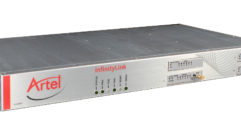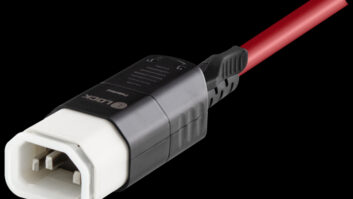Mass migration
May 1, 2000 12:00 PM,
David Parish
Take advantage of a rapidly growing market by learning both why and howvideo technology is moving away from analog and into the digital domain.
Today, the already widespread use of digital video technology in commercialvideo applications is accelerating at a remarkable rate. After years ofbeing a technology in search of a reason to exist, digital video is hot,appearing in applications ranging from in-store merchandising to corporateboardrooms, trade show rentals and video-on-demand in education andtraining. A-V contractors with the skills and experience to design, deployand support digital video systems are learning to reap the benefits oftheir prior investments in developing skills for implementing thesetechnologies. Contractors without plans to upgrade their skills and productofferings are likely to get caught with an increasing share of thedecreasing analog video market. In the short term, this may actually feellike good business. In the long term, it simply is not sustainable.
On the surface, the reasons for the shift towards digital video are thesame as those that accompany any shift away from an established technologyto a newer one. That is, a convergence of price and performance (orfeatures) suddenly creates enough value to push everyone away from the oldparadigm. Also, the explosion of plasma displays on the market, along withthe visual impact they create, has clearly contributed to increasingdemands for video in a widening variety of locations.
The factors underlying this specific paradigm shift, though, run a bitdeeper. The reality is that video has become the manner in which people inWestern societies are accustomed to being informed, entertained andeducated. In that context, commercial users of video are demanding a newand growing set of features from their video installations. We are seeingdemands for more streams of video within locations, cross-streamsynchronization, larger screens, higher resolution, interactivity,combinations of video with computer graphics and high-quality audio, andremote content updating. All of these factors work strongly againstcontinued use of analog video technologies and in favor of digitaltechnologies.
The de facto digital format in the world of commercial video is,undeniably, MPEG-2. Derived from prior incarnations of Motion-JPEG andMPEG-1, MPEG-2 delivers a good combination of high resolution (720 infinity480 NTSC and 720 infinity 576 PAL), high compression and costs that are nowcomparable to existing analog solutions. The growth and adoption of MPEG-2is based largely upon its position as the standard used in both DSS and DVDvideo delivery systems, and it is also the basis of HDTV. The consumersuccess of DSS and DVD has created a broad MPEG-2 industry, resulting in arange of products and services that have driven related costs down andfamiliarity and accessibility up.
MPEG-2 essentials
MPEG-2 is simply a particular file type that resides on a computer’s harddrive. When decoded, through specialized hardware or software, the outputis composite, Y/C or component video. A key element in the application ofMPEG-2 in commercial video is that its digital nature allows it to betransported between locations using standard data transmission systems andprotocols. In other words, LANs, WANs, satellites or any other digital datatransmission systems provide the means for sending video files from onelocation to another. Within certain types of business applications, theability to transport video quickly, easily and inexpensively amonglocations is a breakthrough function, and as such, it will inevitably leadto changes in the way businesses operate.
Consider the retail environment, where video is used for promotional andmerchandising messaging. Most large retailers currently using video in thismanner, including Disney and Discovery Channel Stores, update their contentmonthly or less frequently, a standard based at least in part upon the needto ship new laserdiscs or videotapes to each store every time the contentchanges. An ability to update content through a remote download withinminutes rather than within weeks or months, however, suggests an entirelynew approach to in-store merchandising. Inventory, for example, could beclosely tracked within a given geographic region and temporary promotionscan be downloaded and launched (or even pulled) in response to changinginventory levels. Essentially, micro merchandising now becomes feasible.The key, of course, lies in the download itself. The practicality of thedownload is going to be determined by three factors – the size of the MPEGfiles, the bandwidth of the tra!nsmission channel and the cost per byte for the transmission itself.
The size of the MPEG file is determined by the bit rate of the encodedfile. One can select to encode at bit rates generally ranging between 2Mbps and 15 Mbps (megabits per second) for MPEG-2 files. This is literallythe measure of how much data flows per second as the file is encoded andplays back. Lower bit rates produce lower video quality and smaller files.Higher bit rates yield higher quality video and larger files. The measureof quality here is, of course, subjective and refers to the number of suchvisual artifacts as macroblocking and color confusion that appear duringplayback. The tradeoff in file size, however, is easier to track. Theformula for computing file size for any MPEG file runs as follows:
X/8 infinity 3.6 = GB/hour of video
where X is the encoding bit rate expressed in Mbps.
So, when encoding at 8 Mbps, one hour of video consumes 3.6 GB of hard diskspace. At 4 Mbps, one hour requires 1.8 GB of disk space. These numbersthen translate directly into transmission times (and therefore costs). Inother words, sending one hour of video encoded at 3 Mbps over a satellitecapable of transmitting at 3 Mbps will take one hour.
Digital success
As commercial A-V contractors prepare for this particular version of thefuture, it is important to consider the skill sets required for success inthe digital domain. Not surprisingly, many of the required skills soundsuspiciously like standard PC and networking skills. The specific skillsneeded, however, will vary, depending upon the type of digital videoplayers being used and the complexity of the installations being considered.
Certainly, there is value in understanding the structure of MPEG-2 files(see Figure 2 and Figure 3). An MPEG-2 file is actually composed of threedifferent types of frames, known as I-, B- and P-frames. I-frames, where I-stands for intra-coded pictures, can be thought of as traditional videoframes. The compression calculation that happens on an I-frame is confinedto that particular frame and does not consider what happened on prior orsubsequent frames.
P-frames, on the other hand, consider preceding frames when compressing thedata. For example, if a particular set of pixels does not change in any wayacross a series of prior frames, they can be encoded once and then repeated(or omitted) from frame to frame. Thus, compression is achieved.
Following the same logic, B-frames are bi-directional. They consider bothpreceding and upcoming frames during compression.
Typically, IBP compression is done within a closed group of pictures (GOP),which is a sequence of B- and P-frames that are bounded by I-frames on bothends. A 15-frame GOP is fairly commonly used.
An important practical result of MPEG-2 compression is that B- and P-framesare not video frames in the viewable sense. They make visual sense only inthe context of a sequence of frames but not as a stand-alone entity. Thus,seeking to a random location within an MPEG-2 file may produce a videoframe that is not truly viewable. Typically, one must seek to the nearestI-frame. Although there are various ways around this limitation (forexample, all I-frame encoding or using small GOPs), it does have an impacton how the technology can be deployed and used, especially if the end-useris accustomed to frame-accurate seeking using a laserdisc player.
The process of MPEG-2 compression itself has become greatly simplified asthe technology has gained broad acceptance over the past few years. MPEG-2compression is almost always tied to a specialized device that takes videoin and creates the digital file output directly on a hard drive. The filecan then be burned onto a CD or DVD or transmitted as required. Mosthardware-based MPEG-2 compression systems do their work in real time.Consequently, it takes one hour to compress one hour of video into itsMPEG-2 equivalent.
Several software MPEG-2 compression packages are also available, most ofwhich are not capable of operating in real time. Still, softwarecompression can offer several benefits, including cost and compatibilitywith computer-based video editing and creation systems.
As recently as three years ago, good hardware-based compression systemscost hundreds of thousands of dollars and required highly skilledcompressionists to guide the systems through the process of creating anaccurate rendering of the content. Today, good compression systems can bepurchased for less than $30,000 and are capable of doing an extremely goodjob in a largely automated fashion. To be sure, there are widely divergentdemands on compression that are based upon the content and use. Muchgreater care and precision would be taken while compressing a feature filmthan when compressing a 15 second in-store advertising spot.
Regardless, as contractors move down the path of offering digital solutionsto customers, it is important to be prepared not only to provide answersabout compression services, but possibly also to provide those servicesdirectly. In many ways, doing so provides high value to the customer.Rather than relying upon a third party to burn a laserdisc or DVD, theprocess of creating the final master content is kept within the contractorrelationship. Certainly, it provides an opportunity for fasterresponsiveness.
Video playback
The centerpiece of any contractor’s ability to deploy digital videotechnology is, of course, the specific playback system being sold,installed, configured and serviced. Each available playback system has itsrespective strengths and weaknesses. Each also demands a different skillset from the contractor. Finally, based upon the features of each of thesystems and upon the strengths of the companies that build them, they willfit more naturally into one type of installation or another. There are,however, some common demands that will exist, to a greater or lesserdegree, regardless of which playback system is selected.
All MPEG-2 playback systems are, in the purest sense, computers. If,however, a manufacturer so desires, chip technology allows the computerbehind the system to be well concealed, but doing so requires a tradeoff.To the extent that a playback system is designed to be a device thatrequires little knowledge of computers, its flexibility across a wide rangeof applications will consequently be limited. The Digital Video Machine(DVM) from Alcorn McBride is an example of a well-designed, single-channelMPEG-2 player requiring relatively few computer skills. It can becontrolled through either parallel or serial ports and can also respond tothe Pioneer LDP protocol.
The DVP Server Pro, from Visual Circuits, is at the other end of thespectrum. The DVP is much more of a true MPEG-2 video server. Its PC rootsare front and center. Although it can also be controlled through serial orparallel commands, the DVP lends itself to multichannel video applications(four to 20 streams), offers application software for setup and use thatrequires a keyboard, mouse and monitor, and comes with a software developerkit that allows for custom application development. Clearly, the technicalskill set required to configure, deploy and support the DVP is much moreinvolved than for the Alcorn McBride DVM. Thus, the tradeoff. The DVPoffers greater flexibility and expandability at the cost of demanding moresophisticated technical skills.
Outside of the boundaries of the particular playback system itself,contractors must also consider how the system is likely to be used. Forexample, either system mentioned above, along with others, can work well ina variety of video-on-demand (VOD) settings. Configuring a system into aVOD application may require some knowledge of LANs and WANs, despite thesimple demands of the server on the back end of the VOD system. Really, thequestion of skill development for any contractor should start with anevaluation of the customer base being serviced. A customer base that tendsto push the boundaries of creativity and technology will probably be betterserved by an investment in more complete PC-skill development. On the otherhand, these skills may not apply to mainstream customers.
Technological convergence
The digital nature of MPEG-2 playback systems allows for a naturalconvergence of video with other digital media formats. In particular, thereis growing demand for a combination of digital video with PC (or VGA)graphics. The distinction between the two is, in fact, becoming somewhatblurry, at least as far as end users are concerned. Most plasma screens,for example, are capable of VGA input as well as composite, S-Video or RGBinput. The implication is that regardless of input type, functionalityshould be unaffected. Users are demanding the best of both VGA and digitalvideo, seamlessly integrated with each other.
Although it is possible to decode MPEG files in software and play them backwithin a VGA window, there are limits on resolution and number of channelsthat make this approach impractical within most commercial applications.One can imagine a growing demand for multichannel webcasting combined withmultichannel hardware enabled MPEG-2 decoding in a variety of training,merchandising and entertainment applications. Demands for interactivityalso play a strong role in this convergence. Clearly, as this convergenceof technologies gains momentum, technical skills that allow for combiningvideo with other digital media formats in general, and VGA graphics inparticular, will become extremely important.
The advance of digital media in the commercial A-V world is undeniable. Welive, communicate, entertain, inform, learn and conduct business in adigital world. That means digital words, digital pictures and digitalsounds. The migration of commercial video applications to digital solutionshas begun in earnest and will accelerate from here. Three years ago, onlyone company displayed multichannel digital video servers at Infocomm. Lastyear, there were at least 10 companies showing digital technologies, and Ifully expect that number to increase again this year. Investing in theright skill sets and creating relationships with the right technologyproviders is essential for long-term success as an A-V contractor workingin the commercial world. Not doing so sets the stage to fulfill theprophecy that the fastest way to go out of business is to gain anincreasing share of a decreasing market.










